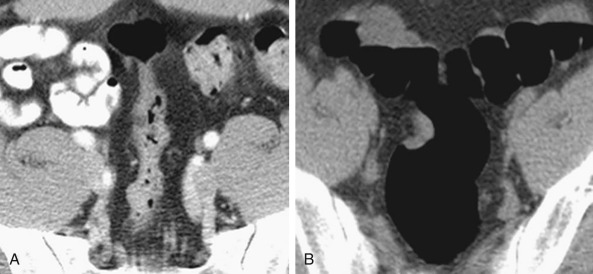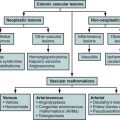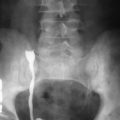Technical Aspects
Colorectal cancer is the second cause of cancer deaths in the United States, second only to lung cancer in men and breast cancer in women. Colorectal cancer screening can be used to identify adenomatous polyps, the precursor lesion to colon cancer for screening symptomatic patients. Computed tomographic (CT) colonography can be simply defined as a highly sophisticated technique that employs rigorous bowel preparation (cleansing) followed by distention of the bowel with air or carbon dioxide (CO 2 ). Multidetector CT (MDCT) is used to acquire volumetric data, and specialized software is used for postprocessing the data sets to generate two-dimensional (2D) multiplanar images or 3D images of the colon. A detailed description of the various techniques and protocols essential for an optimal CT colonography is provided here. In addition, various methods of visualization, interpretation guidelines, and common pitfalls associated with the procedure are discussed.
Technique
Successful CT colonography examination involves the following:
- 1.
Colonic cleansing with tagging of residual stool and luminal fluid
- 2.
Colonic distention
- 3.
Data acquisition
- 4.
Visualization of CT colonography with 2D and 3D techniques
The examination can be entirely performed by a technologist after adequate training with minimal assistance from a radiologist. However, the presence of an onsite radiologist is preferred for consultation in difficult cases.
Colonic Cleansing
The presence of residual fluid or stool will result in a suboptimal CT colonography because it can obscure polyps or neoplasms or make differentiation between polyps and stool difficult. Hence, a robust colonic preparation is perhaps the most important step of the entire study. Colonic cleansing is achieved by combining four basic components: dietary restriction, administration of a cathartic agent, tagging of residual stool, and tagging of residual luminal fluid.
The patient is instructed to consume a clear liquid diet the day before the examination. The main bowel cleansing agents include cathartics such as magnesium citrate and sodium phosphate and gut lavage solutions such as polyethylene glycol (PEG). The two popular commercial preparation kits are the 24-hour Fleet 1 Preparation (Fleet Pharmaceuticals, Lynchburg, VA) and the LoSo Preparation (EZ-EM, Westbury, NY). A time outline for bowel preparation is suggested in Table 30-1 .
| Preparation | Day Before Examination | Morning of CT Colonography | Additional Instructions |
|---|---|---|---|
| Sodium phosphate | 6 pm : 45 mL of sodium phosphate diluted in 4 oz of water orally | 10-mg bisacodyl suppository approximately 1 hr before the examination | Refrain from eating solids and maintain adequate hydration with clear liquids |
| 9 pm : Four bisacodyl tablets (5-mg each) orally | |||
| Magnesium citrate | 4 pm : 200-300 mL (10 oz) of magnesium citrate orally | 10-mg bisacodyl suppository approximately 1 hr before the examination | |
| 6 pm : Four bisacodyl tablets are taken orally with 8 oz of water |
Sodium phosphate is an oral saline cathartic and is referred to as a “dry prep” because it leaves behind little residual fluid in the colon. Magnesium citrate is also a saline cathartic that causes fluid to accumulate in the bowel because of its osmotic effects and promotes peristaltic activity and bowel emptying.
PEG is an effective agent for cleansing the bowel, but it often results in excessive fluid retention in the colon. It is considered a “wet prep” and is not the ideal bowel cleansing agent for virtual colonoscopy. The PEG preparation is associated with the poorest compliance because of its consistency and large volume of ingestion. In a study comparing PEG and sodium phosphate, the majority of the subjects were unable to complete the PEG regimen, whereas 84% of the patients found sodium phosphate to be tolerable compared with only 33% of patients receiving PEG. There is no significant difference between oral sodium phosphate and PEG electrolyte solution in the quality of bowel cleansing. Magnesium citrate can be used in conjunction with a decreased volume (2 L) of PEG lavage solution to reduce preparation time and improve patient tolerance. The advantages and disadvantages of using a dry or wet bowel cleansing agent are illustrated in Table 30-2 .
| Preparation | Advantages | Disadvantages |
|---|---|---|
| Dry prep: Sodium phosphate or magnesium citrate |
| More solid debris along the colonic wall makes three-dimensional endoluminal view more time consuming. |
| Wet prep: Polyethylene glycol |
|
|
Contraindications for Bowel Cleansing Agents
The use of a particular laxative is governed by the health status of the individual. Sodium phosphate can cause electrolyte disturbances leading to hyperphosphatemia, hypocalcemia, and hypernatremia. Hence it should not be used in patients with renal, cardiac, or hepatic insufficiency and preexisting electrolyte abnormalities. Sodium phosphate also should be avoided in elderly hypertensive patients who are taking angiotensin-converting enzyme inhibitors. Although magnesium citrate has been reported to cause electrolyte imbalances, these changes are less pronounced than those seen with sodium phosphate. Magnesium citrate should not be used in patients with renal failure.
Residual Stool and Luminal Fluid Tagging
Dual-positive oral contrast agents are used for tagging of the residual stool and luminal fluid after catharsis. Barium and/or iodine solutions are ingested with meals, usually in conjunction with the oral cathartics, 24 to 48 hours before imaging to allow adequate incorporation of the positive contrast material with colonic contents. Tagged stool and residual fluid demonstrate higher attenuation and are easily discernible from the homogeneous soft tissue density of polyps and colonic folds. Either dilute 2% CT barium or 30% to 40% barium can be used for residual stool tagging; 30% to 40% barium can be very dense and cause artifacts and is also less well tolerated by patients.
Diatrizoate meglumine and diatrizoate sodium solution are used for uniform opacification of the residual luminal fluid, and their added secondary cathartic effects eliminate a significant amount of adherent solid debris. The tagged residual stool and fluid are then eliminated by electronic subtraction of the high-density material. Pickhardt and colleagues demonstrated that patients who underwent residual stool and fluid tagging with electronic subtraction for a CT colonographic study demonstrated higher sensitivity for detection of adenomatous polyps measuring 8 mm or more than with conventional colonoscopy. The use of stool and fluid tagging provides a window of opportunity for possible elimination or significant decrease in the amount of laxative to be consumed by the patient. At present, the American College of Radiology (ACR) practice guideline for performing virtual colonoscopy in adults recommends using oral contrast for labeling stool or fluid when possible.
Colonic Distention
Inadequately distended segments of the colon can make polyp and cancer detection difficult, compromising the sensitivity and specificity of the examination ( Figure 30-1 ). Room air or CO 2 may be used for colonic distention for the virtual colonoscopic examination. CT technologists after adequate training and experience could easily manage to perform the introduction of the rectal catheter. The need for radiologist intervention can be reserved for difficult situations or very apprehensive patients.

Room Air
Advantages of room air include ease of use, ready availability, and lack of additional cost and because it provides good colonic distention. However, because room air is composed predominantly of nitrogen it is poorly absorbed through the colonic wall and patients can experience abdominal discomfort and pain after the CT colonography until the air is totally expelled distally by peristalsis. In addition, significant time may be required to teach patients to self-insufflate with room air, leading to increased operator dependence.
Carbon Dioxide
The patient is advised to evacuate just before the start of the study. Automatic CO 2 insufflation can be a useful alternative to room air for colonic distention. A commercially available electronic insufflation device provides a constant flow of CO 2 into the colon per rectum at a relatively low level of preset pressure to reduce the risk for colonic perforation. CO 2 is absorbed rapidly through the colonic wall and exhaled through the lungs. Shinners and associates have observed decreased postprocedural discomfort and improved colonic distention using automated CO 2 compared with patient-controlled room air. The automated CO 2 procedure is fairly easy to explain to the patient. The automated CO 2 technique can decrease operator dependence. The risk for perforation with automated CO 2 technique or patient-controlled distention methods probably approaches zero for screening CT colonography.
Technique
Room Air.
The patient is advised to evacuate just before the start of the study. With the patient in the left lateral decubitus position a small rubber catheter is used to insufflate the colon with a hand-held bulb syringe. Using an insufflation bulb, 50 to 70 puffs or 2 L of room air is administered until the patient experiences fullness or mild discomfort, which signals that the colon is well distended.
Automated Carbon Dioxide Technique.
In the automated CO 2 technique a small-caliber, flexible rectal catheter is placed with the patient in the left lateral decubitus position and 1.0 to 1.5 L CO 2 is delivered by the automated device at equilibrium pressure of approximately 20 mm Hg. The patient is moved into the right lateral decubitus position until approximately 2.5 L of CO 2 has been introduced. The total volume of CO 2 used in the procedure can vary from 2 to 10 L owing to individual differences in colonic volume, colonic resorption, and reflux through the ileocecal valve. Finally, a scout image of the abdomen and pelvis is obtained with the patient in the supine position. The colonic distention can be checked on the CT scout image or on the review of the 2D transverse images during the examination. Adequate colonic distention will reveal an almost complete column of gas from the rectum to the cecum. Additional CO 2 may be administered with the patient in the prone position if the colon is suboptimally distended. The virtual colonoscopy scan then is repeated in the prone position after a second scout localizing image. Scans performed with the patient in both the supine and prone positions provide improved colonic distention, particularly of the transverse and sigmoid colon compared with supine or prone imaging alone. Although dual-position scanning increases the radiation dose, it facilitates optimal bowel distention and differentiation of fecal material from polyps. Furthermore, persistent segments of focal collapse may need to be scanned with the patient in the right lateral decubitus position.
Use of Spasmolytic Agents
Glucagon
Glucagon causes relaxation of the smooth muscle in the gastrointestinal tract, including the colon, presumably improving patient comfort and colonic distention. The ACR practice guideline suggests that the use of antispasmotics is not necessary for routine examination and no benefit is seen with glucagon.
Hyoscine Butylbromide
This anticholinergic drug is administered intravenously and acts by blocking parasympathetic ganglia, causing relaxation of smooth muscle. Hyoscine butylbromide has been reported to be more effective than glucagon in distending the colon for barium enema examinations. Adverse effects include blurring of vision, dry mouth, tachycardia, and acute urinary retention. Contraindications to the use of hyoscine butylbromide include glaucoma, obstructive uropathy, and myasthenia gravis. It is not approved for use in the United States but has been used widely in Europe and Asia.
The parenteral administration of spasmolytic agents, given their potential adverse reactions, can create added patient anxiety and thereby increase the duration and cost of the examination.
Multidetector Computed Tomography Protocol for Computed Tomographic Colonography
After air or CO 2 insufflation, CT colonography is performed first in the supine position in a cephalocaudad direction encompassing the entire colon and rectum. The patient is then placed in the prone position, and the scan is repeated over the same z-axis range. An optimal study can be performed using 4-, 8-, or 16-channel MDCT scanners with 1.25-mm collimation. The 16- and 64-slice MDCT scanners have considerably decreased scanning times, leading to virtual elimination of motion artifacts from peristalsis and respiration. The 64-slice scanners are generally not necessary because submillimeter collimation results in increased radiation dose. Screening CT colonography is a noncontrast study, and intravenous contrast material is not administered routinely. Oral contrast tagging and 3D polyp detection have a high diagnostic accuracy, making the use of intravenous contrast unnecessary for screening. Disadvantages of the use of intravenous contrast include the possibility of contrast reactions, higher radiation dose, increased interpretation times, and higher cost. Intravenous contrast could pose an added difficulty in differentiating an enhancing lesion from tagged material and should be avoided in patients with oral stool and fluid tagging. A suggested CT colonography MDCT protocol is illustrated in Table 30-3 .
| Technical Parameters | 16-Slice MDCT |
|---|---|
| Scan position | Supine and prone |
| Scan area | Entire abdomen and pelvis |
| Scan direction | Craniocaudal |
| Respiratory phase | Inspiration |
| Detector configuration | 16 × 0.625 mm |
| Pitch | 1.375 |
| Feed table (mm/rotation) | 13.75 |
| Gantry rotation time (s) | 0.5 |
| Kilovolt peak (kVp) | 120 |
| Milliampere (mA) | Smart mA (GE Medical Systems, Milwaukee, WI), with noise index of 50 or 35 to 75 mAs (effective) without automatic tube current modulation |
| Reconstruction | Standard/full |
| Thickness | 1.25 mm |
| Interval | 0.8 mm |
Stay updated, free articles. Join our Telegram channel

Full access? Get Clinical Tree







